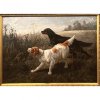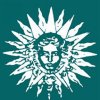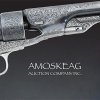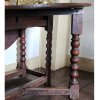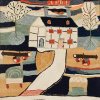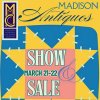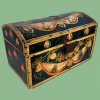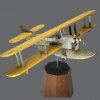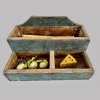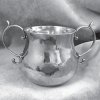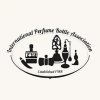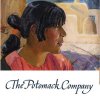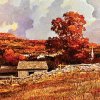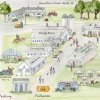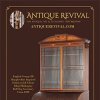“Affordable” Bay Psalm Book Fetches $62,500
March 10th, 2020
Swann Galleries, New York City
Photos courtesy Swann Galleries
An auction reporter’s lead paragraph usually trumpets a record or at least a higher-than-expected price paid for one object or other. This time, the achievement of an “affordable” price for a famous title is one of the newsiest parts of this account of Swann’s printed and manuscript Americana sale on March 10 at its New York City gallery.
As most rare-book aficionados know, a first edition of the first book printed in British North America as The Whole Booke of Psalmes Faithfully Translated into English Metre sold to financier and philanthropist David M. Rubenstein at Sotheby’s on November 26, 2013, for $14.2 million (including buyer’s premium). It is a figure that still stands as the auction record for any single printed book. Following that first edition, printed in Cambridge, Massachusetts, in 1640, came more than two dozen other editions in the 17th and early 18th centuries alone, including one printed for Boston’s Hezekiah Usher (circa 1615-1676), the Colonies’ first-known bookseller. All editions of what is known colloquially as the Bay Psalm Book are rare; some are rarer than others; some are unknown. A very rare seventh edition, for example, published in Boston in 1693, was the top lot at Swann on February 4, 2016. Estimated at $30,000/40,000, it sold for $221,000 to the William Reese Company, New Haven, Connecticut.
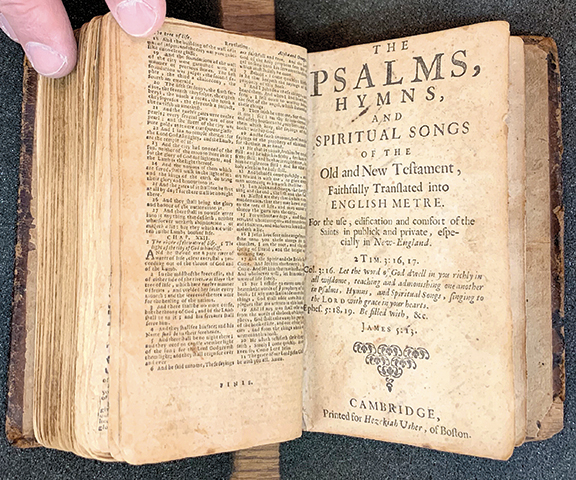
This 17th-century edition of the Bay Psalm Book—the original Biblical Psalms translated into English—sold to a dealer for $62,500 (est. $50,000/75,000). The book, printed for sale by Hezekiah Usher (circa 1615-1676) of Boston, has some question marks that have been longstanding among scholars and bibliographers and may not be soon erased. For one thing, although the title page says “Cambridge” and America’s first print historian, Isaiah Thomas, believed that meant Cambridge, Massachusetts, it is believed to have been printed in Cambridge, England, albeit for American distribution, perhaps because the state of printing in Colonial America was still undeveloped, with paper, ink, and trained printers being scarce. Another of the question marks is its date of publication. Although it was obviously printed at some point during Usher’s lifetime, the exact year is uncertain, with some sources putting it as early as 1648 and others as late as 1665. It isn’t proof of anything, but it’s interesting to note that this copy is bound with a (defective) copy of a 1648 Bible printed by British printer and bookseller Roger Daniel (active 1627-66) for the University of Cambridge. As for provenance, it was inscribed several times by members of the Hapgood family, including Lucy Hapgood (1766-1851) of Shrewsbury, Massachusetts. Schinto photo.
When Swann’s book department head Rick Stattler wrote his catalog description for the Hezekiah Usher edition consigned to this sale, he set its estimate at $50,000/75,000, a conservative range given that the book was the earliest edition of the Psalms up for auction in 50 years. Indeed, a six-figure outcome seemed reasonable to expect—until the coronavirus struck. In the end, the book sold to a phone bidder for $62,500, the low estimate plus the buyer’s premium.
The state of the world’s health and its economy made itself evident throughout the sale. Indeed, for me, its outcome signaled the first sign of real trouble. Of the 370 lots offered, 85 were passed. That is a highly unusual number for this department at Swann. Still, the best items in virtually all categories, especially rare or unique items, found their stalwart bidders and buyers.
A large selection of Mexican imprints, a category that seems never to falter at this auction house, was the strongest part of the sale. Going to a phone bidder at $75,000 was an 1836 broadside printed in Mexico City announcing the fall of the Alamo. Seven of the top 15 lots had the Mexico component. Mormon material, always another reliable category for Swann, got good results too. A bidder paid $75,000 for a first edition of The Book of Mormon that is the only edition listing Joseph Smith as the book’s “author and proprietor” rather than its “translator”; it is also the only one that includes his two-page preface. These were the top two lots of the sale, with the Bay Psalm Book coming in third. All three of these were bought by dealers, Stattler said.

A first edition of The Book of Mormon, published by E.B. Grandin in Palmyra, New York, in 1830, went to a dealer for $75,000 (est. $40,000/60,000). It is inscribed by a succession of owners, some of them believers, some of them blasphemers. The Swann catalog said the consignor bought the book at an antiques store in Maine in the 1990s.
“It was not a bad sale,” he added, noting that many dealers in town for the New York International Antiquarian Book Fair had previewed. “It wasn’t what I had initially hoped for, but with the buyers’ premiums, we were right in the middle of the estimate. I think many buyers are looking at [the economic downturn] as possibly a good time to buy. It’s what we saw during the last one [in 2008].”
Institutions, usually strong participants, did not buy any of the top lots, but they did take 25 of the lower-priced ones, Stattler noted. Certainly they often have dealers acting as agents for them, but a good guess is that museums and research libraries were busy with bigger decisions, such as whether to close their doors, and sadly, in the days that followed, virtually all did.
For more information, see the Swann website (www.swanngalleries.com).

Twelve autograph letters by Samuel Huntting Cook (circa 1828-1888), who went to California in search of gold and stayed despite the failure of his mining efforts, sold to a phone bidder for $10,000 (est. $1500/2500). Originally from Sag Harbor, New York, Cook went on to work at numerous other jobs, including papering and carpeting a gambling house and working as a hotel clerk. The writing, to judge from the sampling in the catalog, is colorful and full of details. At one point he describes sleeping with “a California saddle” for his pillow and an old dog named Mingo at his feet, “like a warm brick.”

A dealer paid $75,000 (est. $40,000/60,000) for this 12½" x 8½" letterpress broadside announcing the fall of the Alamo. Noticia estraordinaria, viva la patria y el ejercito Mexicano was printed in Mexico by Juan Matute in 1836. Thomas W. Streeter wrote in his celebrated Texas bibliography that it was “probably the first announcement in Mexico City” of the Mexicans’ victory. Streeter (1883-1965) knew of only one copy, his own. It is now part of the Streeter collection of Texas material at Yale University. According to Swann, only one other has been up for auction, at Sotheby’s in 2004.

This polar-themed lithograph, “An Exploring Expedition on the Canal Street Plan. / The Exploring Expedition at the South Pole. Waiting for Stores,” sold for $5250 (est. $1200/1800). Published by H.R. Robinson in New York in 1838, the 12½" x 20" print is a satirical treatment of the 1838-42 American expedition to Antarctica. Note that the men huddled around a campfire are cooking a pair of boots.

Pictured is a rarity, with only two institutional copies located and none known at auction since 1967, according to Swann’s research. The item is Constituciones, y leyes municipales de esta Provincia del S. Evangelio,i.e., regulations for a Franciscan province, including reports on conversions in the Californias, New Mexico, and Tampico, Mexico. Printed in Mexico in 1667, the volume bound in calf gilt sold for $9375 (est. $4000/6000).

This 24th edition of the Bay Psalm Book, printed in Boston by S. Kneeland and T. Green for “N. Procter” (Proctor) in 1737, went up directly after the earlier edition, bringing $3500 (est. $2000/3000). Swann research turned up only one other surviving example with the N. Proctor imprint, in the Michael Zinman collection at the Library Company in Philadelphia. This one has some leaves missing.

José Martí’s Verso sencillos sold for $5250 (est. $3000/4000), an auction record price for any work by Martí, according to Swann. Published in New York by Louis Weiss in 1891, the Cuban poet-revolutionary’s final and most important book of verse was inscribed by him as a gift to Nicolas Dominguez Cowan, a member of the Cuban Revolutionary Party and an émigré living in Mexico City.

A medal issued in 1906 to Henry Judson McCullough (1842-1911), a “Utah Indian War Veteran,” who also happened to be a Mormon pioneer, sold with its original red, white, and blue ribbon intact for $1950 (est. $1500/2500). The total length of the item, from the top of its crossbar to the bottom of its sunburst design, is 4". Only two other states, Minnesota and Nebraska, issued similar medals. Schinto photo.

A signed and inscribed carte de visite of London-born Alfred Rudolph Waud (1828-1891), a celebrated American Civil War sketch artist, went for $1625 (est. $500/750). “Yours truly and mournfully, Alfred R. Waud” wrote the artist on the 3½" x 2¼" albumen photographic print from the studio of Alexander Gardner. The sale also featured a couple of Waud artworks (not shown). His early 1863 Virginia scene, an 8¼" x 13" pencil and gouache on paper titled Camp of the 12th Mass. at Belle Plain, Col. James L. Bates, sold for $2125 (est. $2000/3000). Our Center on the Eve of 13th, a signed 2¼" x 4" pencil, pastel, and watercolor on paper, got $1500 (est. $500/750).

The catalog’s cover lot, a Civil War recruitment poster printed in New York in 1863, sold to a dealer for $11,875 (est. $5000/7500). Besides the beauty of its big, bold colors, the 41½" x 29½" illustrated broadside had a connection to Gettysburg, because the Sprague Light Artillery was quickly merged into the 16th New York Cavalry, which fought in that campaign. There was an indirect Lincoln connection too—a detachment from the 16th, under the command of Lieutenant Edward P. Doherty, cornered and killed the president’s assassin, John Wilkes Booth, and captured his accomplice David Herold.

An unauthorized second edition of Alexander Hamilton’s confession of his adulterous affair sold for $10,000 (est. $5000/7000). The publication of Observations on Certain Documents…in which the Charge of Speculation against Alexander Hamilton...Is Fully Refuted, whichwas designed to embarrass Hamilton and damage the Federalist Party by association, was printed in Philadelphia in 1800. Swann sold the same title for the same price on April 12, 2018. Apparently, although Broadway was shuttered by the coronavirus, Hamilton material remains as strong as ever.

What could very well be the world’s most densely handwritten diary sold for $4250 (est. $1500/2500). It is the work of George C. Bryson (1851-1940), a Reno, Nevada, saloonkeeper who later became a police judge in the burgeoning city. A chronicle of observed drinking and drunken behavior (Bryson himself was on the wagon), gambling (in which Bryson regularly participated), bird hunting, current political and sporting events, and so on, the 183 manuscript pages cover the years 1903-17. “To fully transcribe and annotate this diary would be about a five-year project,” Stattler wrote in his catalog without exaggeration. But it would be “a worthy one,” he opined, considering the work’s suitability as the basis for “a compelling television series.” After the sale, he said the buyer was a dealer who is seriously eager to make something of it. Schinto photo.

The papers of sea captain Benjamin Dyer (1793-1871) of Truro, Massachusetts, on the outer portion of Cape Cod, were a dealer purchase at $5500 (est. $2500/3500). Dyer’s archive, whose items date from 1818 to 1860, comprises a logbook, a letter book, a business ledger, correspondence written by him to his family and letters to him from his family, and family photographs, including the one shown here, as well as his small, personal leather-topped writing desk. Captain Dyer was a contractor in 1846-47 during the Mexican-American War. He got caught up in the yellow fever epidemic in New York City in the 1820s. He wrote down matter-of-fact eyewitness accounts and observations of life and death all over the world. The lot was supplemented by hundreds of family papers of Captain Dyer’s descendants documenting their own lives through most of the 20th century.

An early (October 4, 1859) portrait of a beardless Lincoln, who had yet to enter politics at the national level, fetched $6000 (est. $2500/3500). The future president sat for the 7¼" x 5¼" oval salted paper print at the Cooke & Fassett Gallery in Chicago.

George Washington’s first inaugural address in full and an account of his inauguration, published in the pages of the New-York Packet on May 1, 1789, went to a bidder for $15,000 (est. $4000/6000). Other newspapers covered the Washington event, although whether they published the entire speech could not be determined by Swann.

Hands across the Sea, this 23" x 22½" color lithograph print, sold for $1875 (est. $600/900). Published in Toronto in 1907 by James Lydon, it was produced by the Alexander & Cable Lithographing Company. And it is a cross collectible if there ever was one. Theodore Roosevelt is in the oval on the right; King Edward VII is on the left. In the center is the R.M.S. Lusitania, and at the bottom edge, a Masonic symbol.

A cabinet-card portrait of Lucy Parsons (1851-1942), labor organizer, orator, author, and one of the founders of the Industrial Workers of the World, sold for $2250 (est. $800/1200). The 5½" x 3¾" albumen photograph was issued in New York in 1886 by L. Gogler.

Early Mexican manuscript cookery books continue to inspire competitive bidding. A compilation of 82 recipes handwritten by Ana Maria Cruces and dated May 22, 1821, a decade before the first cookbook was published in Mexico, sold to a private collector for $10,400 (est. $3000/4000).

A private collector paid $5250 (est. $2000/3000) for this 1666 manuscript map of a piece of indigenous chinampa farmland, with its accompanying will (not shown). Chinampa is the Nahuatl word for the type of manmade floating island garden developed on lakes by the indigenous people in Mesoamerica. Today one can visit a contemporary chinampa in Xochimilco, in the southern part of Mexico City. For more information, see an article about it in the online version of Smithsonian Magazine (www.smithsonianmag.com/travel/mexicos-floating-gardens-return-their-agricultural-roots-180961899/).
Originally published in the May 2020 issue of Maine Antique Digest. © 2020 Maine Antique Digest

